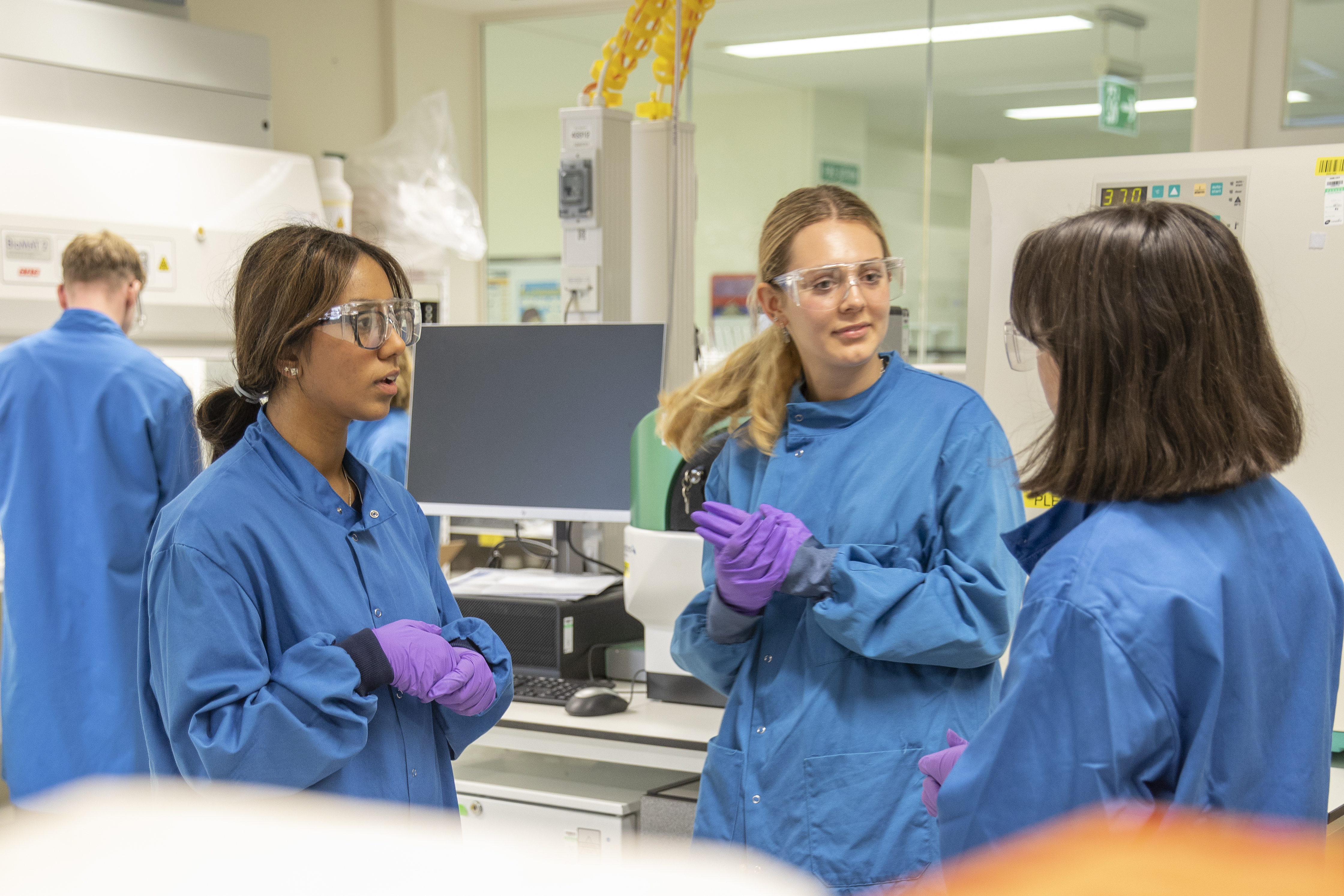Until recently, medicines and vaccines were mainly tested on men. This has had a detrimental effect on the health outcomes of women around the world. However, attitudes are shifting, and GSK scientists are creating new initiatives to ensure that enrolling trial participants of different sexes, genders, races, and ethnicities becomes the new normal.
Historically, it was assumed that there were no fundamental differences between men and women’s bodies other than size, weight, and reproductive organs. Instead, women were perceived as “little men”. The ancient Greek philosopher Aristotle described female bodies as “mutilated males”. His ideas influenced Western medical thinking late into the Middle Ages.
Now, of course, scientists know better. They know that male and female bodies are genetically different, that they experience differences in the prevalence, course and severity of many common human diseases and metabolise foreign substances – like medicines and vaccines – differently. They also recognise that varying demographics – ethnicity, gender identity, social class, sexuality and more – have an impact on the health outcomes of patients. Yet until very recently, the male medical standard has stayed much the same.
A 2008 study of medical textbooks recommended by 20 of the most prestigious universities found that heterosexual white male bodies were pictured three times more often than women’s bodies to illustrate neutral body parts. Meanwhile, huge gaps in sex-specific data due the inadequate inclusion of female participants in clinical research has placed millions of women in danger. For example, most early research into coronary heart disease (CHD) was conducted on men, despite the fact 80% of women between the ages of 40 and 60 have one of more risk factors associated with CHD – a leading cause of death for women – and experience life-threatening symptoms of heart attacks differently.
In 2013, the US Food and Drug Administration (FDA) intervened to correct the dosage of sleeping medication containing the active ingredient zolpidem for women, because the recommended dose – based on male bodies – impaired alertness, putting patients at risk of accidents when driving to work the next morning.
“Most people don’t know that still today you can be prescribed a medication that has not been tested on someone like you,” says Kathryn Schubert, CEO and President of the Society for Women’s Health Research (SWHR), a US organisation founded in 1990 to promote research on biological sex differences and disease.
“For a long time, the general thinking was that women were little men, and the introduction of hormones in scientific research was a challenge that nobody wanted to be bothered with.”
The effect on the health outcomes of women, she says, have been “detrimental”.
“Women are often ignored or not listened to or dismissed [by healthcare professionals]…The length of diagnosis time has been impacted, and our knowledge of what women’s health impact is and what disease impact is has been compromised.”
“We’re not a world of men - it is as simple as that,” says Nivi Thyagarajan, global co-lead of the Women’s Leadership Initiative at GSK – a 9,000-strong Employee Resource Group that promotes gender parity.
“If we were a completely homogenous population where everyone on the planet was a white male, then we would be having a different conversation. But our world is incredibly diverse, incredibly heterogenous, there is such a broad spectrum, so clinical trials need to represent that.”
Barriers to representation
In 2011, the Society of Women’s Health Research partnered with the FDA to examine why clinical trials lacked female participants – and what could be done to overcome barriers to their participation. They found that traditional trial designs did not consider the needs of diverse candidates.
“For women there are many different barriers to what the folks who designed the trial are thinking,” Schubert says. “Things like childcare, transportation, flexible times. Women are really busy. We are the last people to focus on ourselves. If I have a spouse that’s sick and I want to get them into a clinical trial, I will do everything I can to do that, but if it’s me, it’s probably not as likely.”
Building trust is also key to recruiting and retaining female trial participants.
“Having worked in clinical trials myself at GSK, I know how important the voice of the physician is in recruiting and driving these important trials,” Thyagarajan continues.
“When you are recruiting people into trials, how do physicians encourage potential candidates to be a part of a trial? How are you going to convince them to get into a trial? It’s a trial medication, it’s a trial vaccine, it is something that isn’t widely available yet. So trust and confidence in a physician an integral part of this.”
Women are not a homogenous group, but a diverse population that faces intersecting challenges. Therefore, Thyagarajan concludes, the designers and investigators of clinical trials should also reflect the populations most affected by the disease.
“If you are someone who doesn’t relate to a diverse population, whether that is female, whether that’s sexual orientation, whether that’s disability, whether that’s race and ethnicity… if you can’t relate to them in some way, then you are going to struggle recruiting.”
Taking action
Determined to design studies that better represent epidemiological rates – the number of cases of a disease – of different populations in the future, GSK researchers recently reviewed 17 years of its own US-based trials. Analysing data from more than 100,000 participants in 495 studies, it identified some mismatches between the demographics of participants and how prevalent diseases were in respective populations.
In trials for asthma drugs, African Americans made up 22.6% of participants — exceeding the 13.4% they represent in the US population, as well as the 17% share of asthma patients comprised by African Americans. However, in HIV trials, enrolment of African American participants was at 35.1%. This was higher than census levels of 13.4%, but significantly lower than the 55.3% share the group represents among HIV patients.
“If you look at any disease, the percentage of women that actually have the disease should be represented in your clinical trials,” Dr Tania Small, Vice President of global medical affairs for oncology and chair of diversity, equity and inclusion for the R&D Council at GSK, says.
“So, because GSK feels strongly about representing the real-world patient population in our clinical trials, we want to identify and understand the epidemiology and demographics of a disease, and make sure that we outline that in all our target medicine profiles.
“We are making sure we have a plan in place for every Phase 3 study to recruit the population that actually has that disease, and that includes accounting for gender.”
GSK are also partnering with various patient advocacy groups that focus on women and women’s health so they can help researchers design the right studies for women.
“We already have some great examples of where we’re doing this well, such as our partnership with the organisation MiOra to increase the participation of Hispanic and African American women in ovarian cancer trials,” Small continues.
Unconscious bias
“Another part of our plan for ensuring our clinical trials are inclusive and diverse is actually training physicians in how to recruit diverse patients for a specific disease.
“Our goal is to train around 15,000 clinical trial staff members in how to have these conversations, and how to understand our own unconscious biases that could prevent us from reaching the right people.”
Unconscious biases are the attitudes or stereotypes that people hold in the unconscious part of their brain. They may not match how a person feels when they give conscious thought to the subject but may influence their decision-making and judgements in subtler ways.
“A lot of times people state that there is a trust issue for women of colour in healthcare. But we know that the reason for lack of diversity in our clinical trials is much more profound and is multi-factorial which include clinical trial design, logistical barriers, access and unfortunately our own unconscious biases and assumptions. In a 2022 study, 80% of black women with breast cancer said they would love to participate in clinical trials. However only 40% of them were offered these clinical trials.
“We see the same bias right across healthcare – and in the US with healthcare insurance coverage. Almost one in five transpeople have been denied care simply because of their trans identity, so we are talking about a real healthcare crisis. People are dying because they are not getting access to medicines and trials due to biases.”
A fairer future
There is some way to go to achieve representative diversity in all clinical trials globally, but progress on including women has been encouraging.
“It has gotten a lot better over the last 30 years, and the FDA has reported that we’re pretty close to 50% men and 50% women in some areas,” says Schubert, President of the Society of Women’s Health Research.
“We’re in the process this year of going back through our 2011 FDA report to determine how far we have come – and I think we have a long way to go, specifically in the diversity of trial participants,” Schubert continues. “We know there are more women in trials now. My guess is that these are mostly white women.”
A law signed by President Joe Biden in December 2022 will require researchers and companies seeking approval for late-stage clinical trials to submit a plan for ensuring diversity among trial participants to the FDA. However, the proposals are still in draft stages and may take several years to come into effect.
“Ten or 15 years ago, this wasn’t even a topic that I was a part of,” Small concludes. “When we thought about baselines to enter clinical trials, it was always just basically white males… There wasn’t even a discussion of how diseases affect women differently.
“In the last five years I’ve seen an intensity in the effort to understand and put processes in place to change the way we view this and change the way we even do medicine dosing with more individualised plans.
“The paradox is changing, the dynamic is changing, and people are thinking more about how we ensure the drugs we are creating actually serve the broader population and takes gender into account.”





